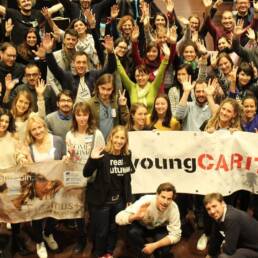Author
Charel Krieps
Humanitarian Officer
Caritas Europa
Many Caritas organisations work with volunteers.
As a principle, volunteers do not earn a salary; their work has nonetheless an economic value, in addition to the social value. Measuring this economic value can be useful to demonstrate how much volunteers contribute to your organisation.
What is the economic value of a volunteer’s work?
Organisations working with volunteers often don’t know that the work of the volunteers has an economic value that can be calculated. In order to calculate this value, you need to have some basic information about the work the volunteers do. Do you know how many volunteering hours were provided in your organisation last year?
Let’s say the volunteers in your organisation worked 3,000 hours last year. And let’s keep it simple and say that each hour a volunteer worked was worth at least 5€. This means that the work of the volunteers is equivalent to a value of 3,000 x 5 = 15,000€.
Why calculate this value?
Once you know the economic value of your volunteers’ work, it is much easier for you to lobby senior management to allocate a budget to manage the volunteers, because you can prove that there is a return on this investment. Organisations often do not allocate a budget for volunteering because volunteers do not get paid. That does not mean however that they do not cost anything. Each organisation working with volunteers needs to have some funding available to manage and maintain their volunteers. If you know that the volunteers in your organisation create an economic value of for example 15,000€ each year, it will be much easier for you to justify why your organisation should allocate a budget for volunteer management. If volunteers create 15,000€ of value for your organisation, it is hard to argue that this does not deserve a 2,000€ budget!
Knowing the economic value of volunteering can also be used as a motivation for the volunteers in your organisation. You can tell them exactly what the added value of their work is, and how your organisation is directly benefiting from the work provided by each volunteer.
In addition, you can explain to donors how your volunteers are an added value to the work of your staff that do not cost much but create a lot of value. Some donors accept the value of the volunteer work as in kind contribution to the project they co-fund.
How to calculate this value?
Start by collecting the number of hours each volunteer works in your organisation. There are several ways to calculate the economic value of the work provided by volunteers. Depending on the method you choose, you might also need to ask the volunteers for their profession outside of volunteering as well as their hourly wage or collect data on the type of volunteering activity they do in the organisation.
Let’s say our organisation works with three volunteers. They all have the same task – to maintain a kindergarten building. One volunteer is a professional IT specialist earning 48€ per hour in his or her real job, another one an electrician earning 17€ in his or her real job, and the third one is a student with no income.
| Profession of the volunteer | Hourly wage of the volunteer | Type of volunteering activity | Financial value of 1 volunteering hour | |||||
| Method 1:
Minimum wage |
Method 2:
Medium wage |
Method 3:
Current wage |
Method 4:
Industry wage |
Method 5:
Replacement cost |
Method 6:
Self-evaluation |
|||
| IT specialist | 48€ | Maintenance of a kindergarten building | 9.32€ | 20.81€ | 48€ | 12€ | 10€ | 15€ |
| Electrician | 17€ | 9.32€ | 20.81€ | 17€ | 12€ | 10€ | 25€ | |
| Not employed (student) | 0€ | 9.32€ | 20.81€ | 0€ | 12€ | 10€ | 7€ | |
A commonly used method to calculate the economic value of the volunteer work is Method 1 in our table above: the minimum hourly wage. With this method, we do not look at how much each volunteer earns in his or her profession, we simply use the legal minimum wage per hour. Then we just need to multiply the volunteering hours of each volunteer over a certain period (e.g. a month or a year) with the minimum hourly wage to obtain the economic value of the work of each volunteer.
To obtain the legal minimum wage per hour, we divide the monthly legal minimum wage by the number of working hours per month. In Belgium for example, the legal minimum gross wage per month was around 1,600€ in 2020. The average number of working hours per month was 171. Therefore, the legal minimum wage per hour was 1,600€ / 171 = 9.32€
Method 2 is similar but uses the medium hourly wage. This means that we don’t use the cheapest possible cost (i.e. the minimum hourly wage) as the basis of our calculation, but medium salary for all professions on the market. In 2017, the Belgian medium gross salary was 3,558€ per month which gives us a medium hourly wage of 3,558€ / 171 = 20.81€.
Method 3 in our table is the current wage method. For this method, you simply use the hourly salary of the volunteer’s actual job as the basis of your calculation. We do not recommend this method, as you need to ask the volunteers to share with you their exact hourly salary (which can be a sensitive topic), and because often the work they do as volunteers is not in the same field as the work they do professionally.
An alternative can therefore be Method 4 or the industry wage method. We look at the average wage of the people working in the sector of the volunteering work. In our example, the volunteers maintain a kindergarten building. If we say that on average a maintenance work costs 12€ per hour, then we use 12€ as the basis of our calculation.
Our Method 5 consists of the replacement cost: what would it cost you if you did not have volunteers doing this work but would need to pay someone to get the same service? If we consider that hiring an external company for several hours every week to do the work that the volunteers are currently doing would cost 10€ per hour, we use this cost to calculate the economic value of volunteering.
Finally, by using Method 6 or the self-evaluation method, you ask the volunteers themselves what they think their volunteer work is worth. Be aware that the answers may vary greatly and not be very consistent.
The most commonly used methods to calculate the economic value of volunteers are Method 1 (minimum wage) and Method 2 (medium wage), especially when the volunteers undertake general roles that you cannot classify easily. If all of your volunteers undertake very specific roles, such as animation activities with children, you might want to use Method 4 (industry wage) or Method 5 (replacement cost).
But whichever method you choose, be consistent and always use the same method. You cannot use different methods with different volunteers.
If this seems very complicated to you, we recommend that you start small. If you have one specific project that involves volunteers, you can start doing this calculation for just this one project before you calculate it for the entire organisation. Even for one project, you will be surprised by the economic value that you come up with.
How do I start?
Now that you know the different methods that exist, you need to establish a system that allows every volunteer to record the hours they volunteer in your organisation (for example through timesheets), you need to decide which method is the most appropriate for your organisation, and for which period you would like to calculate the economic value of your volunteers (e.g. a project, a month, a year). Finally, once you calculate the economic value, you can report this figure to your volunteers, the management of your organisation, your donors, your supporters, policy maker or the public. But remember that this value is always just an estimate and the real value of the volunteer work is reflected in increased solidarity and a better life for beneficiaries of the volunteer work.
References
Salamon, Lester M.; Sokolowski, Woijciech; Haddock, Megan. ‘Measuring the Economic Value of Volunteer Work Globally: Concepts, Estimates, and a Roadmap to the Future’ in Annals of Public and Cooperative Economics, Volume 82, 2011, pp. 217-252: http://ccss.jhu.edu/wp-content/uploads/downloads/2011/10/Annals-Septmeber-2011.pdf.












